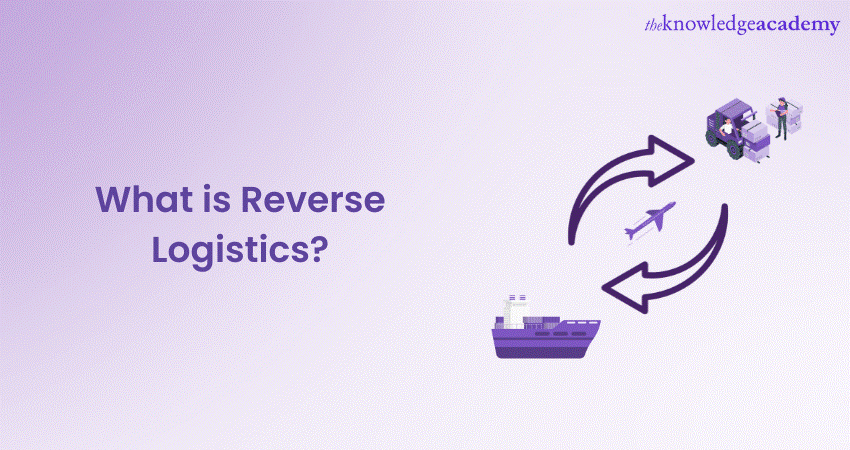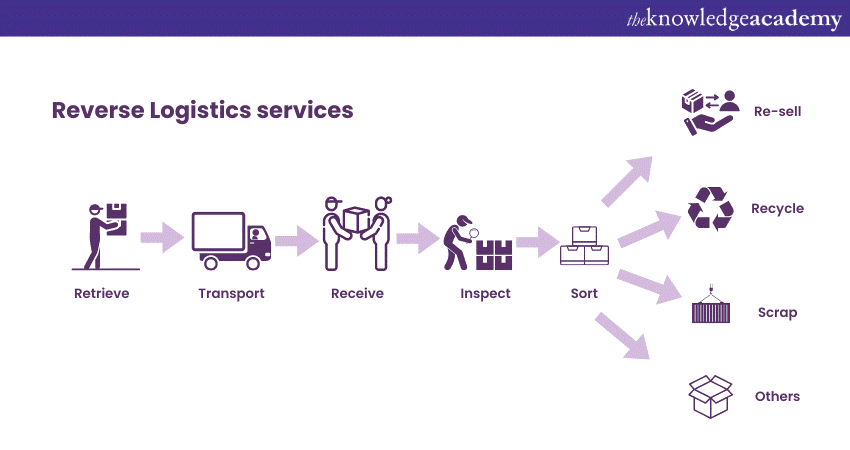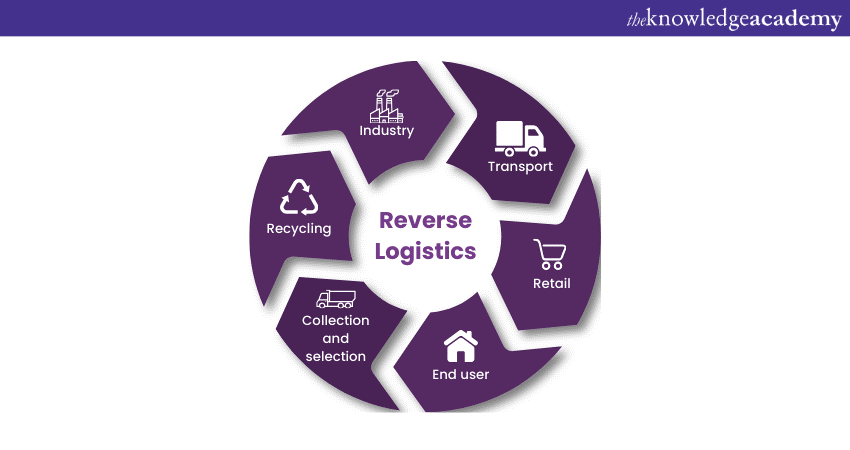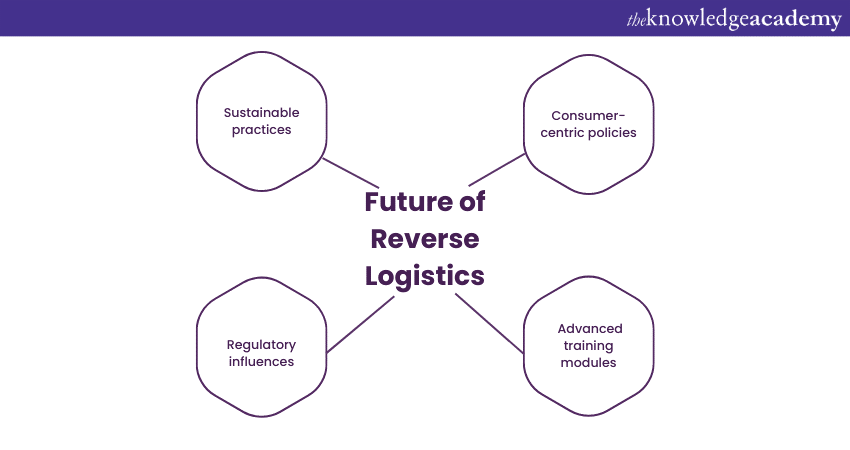We may not have the course you’re looking for. If you enquire or give us a call on 44 1344 203 999 and speak to our training experts, we may still be able to help with your training requirements.
Training Outcomes Within Your Budget!
We ensure quality, budget-alignment, and timely delivery by our expert instructors.

What is Reverse Logistics? It's the process that ensures products move from their typical destination back to the manufacturer or service centre. Many products come with warranties, and when consumers encounter a defect within this period, these products often need returning. Efficient Reverse Logistics operations make sure these returns are smooth and effective, addressing this major issue seamlessly.
An efficient Reverse Logistics process can be more cost-effective in the long run. It helps businesses identify consistent product issues, reduce waste, and manage inventory better, which can lead to substantial cost savings. In this blog, we will discuss What is Reverse Logistics and how it can help a company reuse returned products from a consumer.
Table of Contents
1) Reverse Logistics- an overview
2) Distinguishing Reverse Logistics from Traditional Logistics
3) The significance of Reverse Logistics in modern trade
4) Integral components of Reverse Logistics
5) Navigating the challenges of Reverse Logistics
6) Peering into the future: The evolving landscape of Reverse Logistics
7) Case studies: Successes and lessons in Reverse Logistics
8) Conclusion
Reverse Logistics- an overview
Reverse Logistics involves managing the flow of products and materials in the opposite direction of traditional supply chains, from consumers back to manufacturers or designated locations. This process encompasses returns management, remanufacturing, recycling, warranty recovery, and proper disposal. It offers benefits such as cost savings, sustainability, improved customer satisfaction, and resource optimisation. However, it also presents challenges, including complexity, costs, regulatory compliance, and the need for effective data management. Organisations that effectively implement reverse logistics can recover value from returned items, reduce waste, and meet environmental and regulatory standards, ultimately enhancing their operational efficiency and sustainability efforts.
Unlock your potential in Logistics management today with our Logistics Management Training!
Distinguishing Reverse Logistics from Traditional Logistics
Logistics' primary goal is ensuring products reach their destinations. Traditional Logistics focuses on a forward motion. This means transporting goods from producers to consumers. It aims for efficiency, timeliness, and cost-effectiveness.
On the other hand, Reverse Logistics is the inverse. It handles the flow of products from end-users back to origin points. It’s not just about returns but also repairs, recycling, and more. The journey here can be for various reasons. Unsatisfied customers might return defective products. Or, items might be sent back for refurbishment. The figure below will offer a better understanding:

The objectives of both processes are distinct. Traditional Logistics prioritises speedy, safe delivery to customers. It's about getting products to market and in consumers' hands. The main challenges here include warehousing, distribution, and inventory management.
Reverse Logistics, conversely, prioritises returns management. Its challenges are more multifaceted. It's about managing product life cycles post-consumption. For instance, how does a company efficiently process a return? Or how can they repurpose or recycle returned goods?
Cost dynamics also differ between the two. In traditional Logistics, costs are incurred in transportation, storage, and distribution. In Reverse Logistics, costs arise from processing returns, refurbishing, and waste management.
Moreover, the end goals are different. For traditional Logistics, it's a successful sale. For Reverse Logistics, it's successful integration of returned items. This could mean resale, recycling, or proper disposal.
While both processes deal with the flow of goods, their focus is opposite. Understanding this distinction helps businesses in optimising both forward and reverse flows. And it ensures efficiency, sustainability, and customer satisfaction across the board.
Keen to understand how logistics impact business workflow, refer to our blog on Importance of Logistics.
The significance of Reverse Logistics in modern trade
Reverse Logistics, once an afterthought, is now a cornerstone of modern commerce. With the e-commerce boom and rising consumer expectations, Reverse Logistics is at the forefront of reshaping trade dynamics, making it indispensable for businesses.
E-Commerce boom
The digital revolution has drastically increased online shopping. Consumers enjoy the convenience of home deliveries. With that, however, comes a higher frequency of returns. Sizes might not fit, or products might not meet expectations. Hence, with more parcels going out, a significant number find their way back, necessitating a streamlined Reverse Logistics process to handle this influx.
Consumer expectations
Customer service now extends far beyond the point of sale. Modern shoppers demand flexibility in returns and swift problem resolutions. Their loyalty often hinges on post-purchase experiences. Businesses that fail to offer efficient return processes risk losing customers to competitors who do.
Environmental accountability
As environmental concerns heighten, businesses face increased scrutiny. Today's consumers want eco-friendly products and responsible disposal practices. A well-managed Reverse Logistics system can facilitate recycling, repurposing, and reducing waste, emphasising a brand's commitment to sustainability. The following image shows how reverse logistic takes environmental accountability.

Financial implications
Managing returns effectively has a direct financial impact. Costs can skyrocket with disorganised return processes – think storage fees, wastage, and transportation. In contrast, a streamlined Reverse Logistics approach can recoup potential losses, either by reselling returned items or repurposing them, thereby minimising waste.
Regulatory landscape
Compliance is becoming complex. With governments championing sustainability, regulations about waste management are tightening. Proper Reverse Logistics ensures that businesses stay within legal boundaries. Non-compliance doesn't just risk fines but can also tarnish brand reputation.
Brand reputation
Today's consumers share their experiences widely, thanks to social media. A single bad return experience can spread like wildfire, harming a brand's image. Conversely, efficient and hassle-free return processes can serve as positive endorsements, enhancing a company's public perception.
Dive into diverse industry training with our Industry Training now!
Integral components of Reverse Logistics
A diversified approach to Reverse Logistics demands an understanding of each component. By optimising each element, businesses can achieve efficiency, promote sustainability, and ensure customer satisfaction. It's a win-win situation for companies, consumers, and the planet.
Returns management
This is the foundation of Reverse Logistics. Products come back for various reasons: Defects, dissatisfaction, or incorrect orders. Properly managing these returns involves assessing their condition, routing them appropriately, and ensuring timely processing. A robust returns management system reduces costs and enhances customer trust.
Remanufacturing and refurbishing
Beyond mere repairs, remanufacturing revitalises products. Components are replaced, and items are tested rigorously. Refurbishing focuses on minor repairs and cosmetic enhancements. Both extend a product’s lifecycle, reducing waste and tapping into new customer segments.
Repurposing and recycling
Not every return goes back to shelves. Some products find new roles. Repurposing involves adapting items for new uses. Recycling breaks them down, extracting valuable materials. These processes conserve resources, underscore a brand's commitment to sustainability, and can unlock additional revenue streams.
Warranty recovery
Warranties promise reliability. When products fail within warranty periods, they’re sent back. Manufacturers diagnose, fix, and often replace faulty components. Efficient warranty recovery processes can bolster a brand's reputation, ensuring consumers feel valued and protected.
Asset recovery
Leased or rented items must eventually return to businesses. Timely and efficient asset recovery ensures these valuable items aren't lost or damaged. This component safeguards a company's assets, ensuring continued revenue generation through reuse.
Packaging reuse
In an eco-conscious world, disposable packaging is passé. Many companies now employ reusable containers or packaging materials. This also saves significant costs over multiple shipping cycles.
Disposition management
Every returned item needs a path. Should it be resold? Recycled? Donated? Discarded? Disposition management makes these calls. Effective decision-making here aligns with a company's sustainability goals and financial interests, ensuring minimal waste and optimal resource utilisation.
Reverse Logistics software
Digital transformation is reshaping Reverse Logistics. Software solutions provide real-time tracking, analytics, and automation. They enhance visibility, speed up processes, and offer data-driven insights, making the entire system more resilient and responsive.
Navigating the challenges of Reverse Logistics
Challenges in Reverse Logistics are numerous. Yet, with informed planning, technological adoption, and a keen focus on sustainability and consumer needs, businesses can turn these challenges into growth avenues. Addressing these challenges ensures efficiency and maximised benefits.
High volume of returns
E-commerce's rise means more returns. A surge in return volume can strain systems. Addressing this demands scalable solutions and adaptive processes. Keeping up ensures minimal disruption and enhanced profitability.
Quality control and assessment
Every return tells a story. Some are resaleable, others aren’t. Assessing product conditions quickly and accurately is vital. Proper categorisation ensures suitable pathways, be it resale, recycling, or disposal.
Environmental considerations
The green movement is influential. Businesses are under scrutiny for their environmental footprints. Tackling product disposal, promoting repurposing, and championing recycling are necessary. It's about eco-friendliness and positive brand perception.
Technological integration
Digital tools streamline Reverse Logistics. But integration challenges persist. Ensuring compatibility, upgrading legacy systems, and embracing automation are key. With the right tech support, processes become more transparent and efficient.
Cost management
Financial implications of returns are significant. There's shipping, processing, potential repackaging, and restocking. Strategising to minimise these costs, without compromising service quality, is essential for a healthy bottom line.
Space and storage
Warehousing returns is an art. It requires space optimisation, quick processing, and effective categorisation. Balancing storage needs with fast-paced return inflows ensures smooth operations and reduces overheads.
Regulatory compliance
Global operations mean varied rules. Different regions dictate unique waste and recycling regulations. Navigating this regulatory maze requires vigilance. Compliance protects against legal repercussions and enhances brand credibility.
Consumer expectations
Return policies influence purchase decisions. Consumers want easy, fast, and transparent return processes. Delivering on these expectations, amidst logistical challenges, requires innovative customer-centric strategies.
Training and manpower
Reverse Logistics is specialised. It's different from forward Logistics. Training teams adequately ensures they handle returns effectively. Investing in human resources optimises operations and ensures consistency.
Peering into the future: The evolving landscape of Reverse Logistics
As we look into Reverse Logistics' future, the blend of technology, sustainability, and consumer-centricity is evident. Businesses that adapt, innovate, and collaborate are poised to thrive in this evolving landscape. With shifts in technology, sustainability, and consumer demands, its future landscape beckons keen attention.

Technology-driven solutions
Digital transformation is imminent. Automated sorting systems, AI-powered analytics, and blockchain for traceability will redefine Reverse Logistics. These tech integrations promise enhanced efficiency and transparency in operations.
Sustainable practices
Eco-consciousness is the way forward. Companies will lean more on biodegradable packaging, renewable energy in warehousing, and waste-minimising processes. Sustainability won't just be a trend; it will be a mandate.
Data Analytics and insights
Data will be the compass. By analysing returns, businesses can pre-emptively address product issues. Insights will drive process refinements, enhancing overall product quality and reducing return rates.
Decentralised return centers
Centralised models may fade. Pop-up return centers or localised hubs may emerge, catering to specific regions. This decentralisation can lead to faster processing and reduced transport emissions.
Consumer-centric policies
The consumer reigns supreme. Return policies will evolve, offering more flexibility. Brands might introduce longer return windows, interactive return portals, and instant refunds, elevating the post-purchase experience.
Integration with circular economy
Waste will find disdain. Products will be designed for longevity and recyclability. Reverse Logistics will be a linchpin in ensuring products and materials continually circulate, maximising utility and reducing landfill contributions.
Advanced training modules
Training will evolve in tandem. Augmented reality and virtual reality might be employed to simulate Reverse Logistics scenarios. These immersive training methods can elevate employee proficiency and readiness.
Collaborations and partnerships
Synergy will be a watchword. Businesses might join hands with tech innovators, green initiatives, or even competitors. Such collaborations can spur shared return hubs, technology integrations, or joint sustainability ventures.
Regulatory influences
Policy frameworks will adapt. Stricter guidelines around environmental accountability, consumer rights, and product lifecycle management may surface. Adherence will be crucial to avoid penalties and safeguard brand reputation.
Case studies: Successes and lessons in Reverse Logistics
Case studies illuminate the myriad ways businesses embrace Reverse Logistics. By analysing successes and learning from challenges, companies can tailor robust, effective Reverse Logistics strategies. Exploring specific case studies unveils the practical side of Reverse Logistics, its impact, successes, and lessons.
Amazon's hassle-free Returns
Amazon return process is a testament to this commitment. By implementing seamless return procedures, Amazon has ingrained a sense of trust and reliability among its users. Their advanced sorting algorithms efficiently categorise returns, streamlining the process. The primary lesson here is clear: an investment in enhancing the user experience directly correlates with increased customer loyalty.
Apple's recycling Initiative
Apple introduced 'Daisy', an innovative robot dedicated to iPhone recycling. By encouraging device trade-ins, Apple significantly reduces electronic waste. Such initiatives underscore a key lesson: aligning brand responsibility with action not only fosters sustainability but also amplifies customer appreciation.
H&M's garment collection program
Marrying fashion with responsibility, H&M has charted a course that other retailers might well emulate. Across its global stores, the brand accepts old garments from customers, championing the cause of textile recycling. In collaboration with I:CO, these textiles find new purposes, either being repurposed or recycled. The takeaway is enlightening sustainability initiatives can be woven into the very fabric of retail, enhancing brand value and environmental responsibility.
Best buy's electronics recycling
Best Buy’s initiative offers free in-store electronics recycling, irrespective of where the product was originally purchased. Furthermore, their partnership with certified recyclers guarantees environmentally safe disposal practices. The lesson? Establishing a brand as eco-conscious and proactive can serve as a significant market differentiator, appealing to a wide swath of environmentally aware consumers.
Conclusion
What is Reverse Logistics? It's the system through which returned goods are managed. These goods can be refurbished and resold, recycled, or disposed of. Such management ensures warehouses aren't cluttered with unusable items, optimising both space and resources. Additionally, Reverse Logistics helps businesses pinpoint recurring product issues, minimising waste.
Master supply chain intricacies with our Supply Chain Management Training. Register now!
Frequently Asked Questions
Upcoming Business Skills Resources Batches & Dates
Date
 Logistics Management Training
Logistics Management Training
Fri 24th Jan 2025
Fri 21st Mar 2025
Fri 2nd May 2025
Fri 29th Aug 2025
Fri 3rd Oct 2025
Fri 5th Dec 2025







 Top Rated Course
Top Rated Course



 If you wish to make any changes to your course, please
If you wish to make any changes to your course, please


